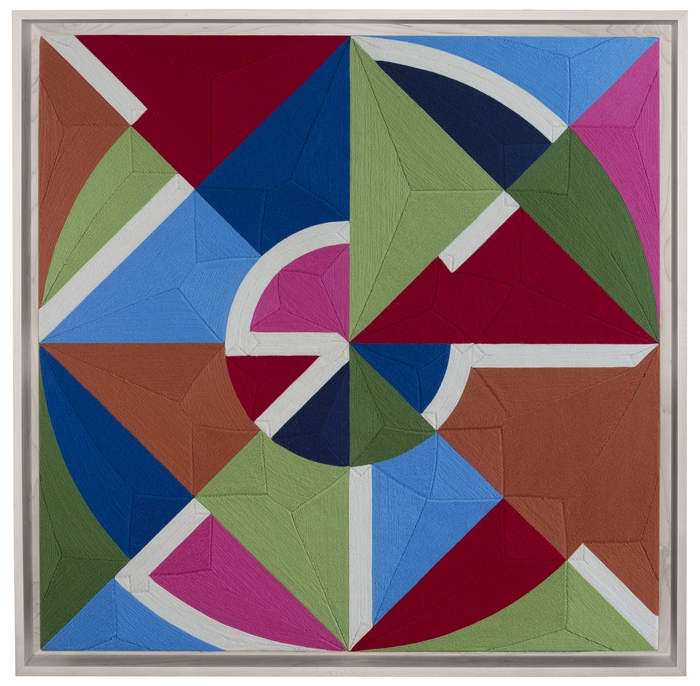I last saw Eduardo Terrazas in Paris, during his exhibition at Almine Rech Gallery in September 2013. Also present were his son and daughter, both very attractive and in their thirties, along with a gathering of people of mixed ages – a little girl pushing the giant inflatable balloon-ball that marked the entrance, hip youngsters admiring the ‘trippy’ patterns in the artist’s work, elderly couples looking at prices or simply enjoying the bursts of colour inside the white gallery space – a testimony to the vitality of his work.
If Terrazas has often seemed a forgotten artist amid the Pleiades of internationally known Mexican art stars (Gabriel Orozco, Teresa Margolles, Mario García Torres and Damián Ortega, not to mention Mexican adoptees Santiago Sierra and Francis Alÿs), it appears that attention has been shifting of late to his work, not just as an artist but also as an architect and designer. Before 2012 Terrazas had only participated in a handful of exhibitions and worked primarily as an architect while developing his work as an artist (almost in secret, one might think); he has since been invited to the Sharjah Biennial and for conversations with Hans Ulrich Obrist at Art Basel, and he has just finished a show at Nils Staerk in Copenhagen, while planning further exhibitions in Mexico and abroad.
Until now, Terrazas seemed to be an ‘artist’s artist’: a favourite among a younger generation of Mexicans, including his gallerist, José García, at Mexico City’s Proyectos Monclova, who have been rediscovering the value of a whole school of modernist thought in Mexico, starting with Luis Barragán and continuing on to Mathias Goeritz and Terrazas (who showed at Mexico City’s Galería OMR during the 1980s), among others.
While still a young architect, Terrazas came to prominence as codesigner (with architect Pedro Ramírez Vázquez) of the logo for the 1968 Olympic Games in Mexico and the event’s entire aesthetics. But even before then he had been working beyond the scope of his field of training. He had been a museographer, alongside Fernando Gamboa, of national folk and archaeological art treasures, whose influences turned up in his Possibilities of a Structure yarn-paintings, a Huichol-technique series begun in 1974. These are made up of geometric abstract patterns, mathematically declined and mostly in bright colours (but not always; some are very faintly coloured, although still quite stunning in their discreet intensity), and one finds echoes of them in Gabriel Orozco’s own well-known variations of circular motifs.
Terrazas’s collaborations (in terms of both inspiration and fabrication) with the Huichol (a Native American ethnic group of western central Mexico), and especially with artist Santos Motoaaopohua de la Torre de Santiago, don’t stop there: some of his most recent works use the traditional beading technique of the Huichol, where tiny multicoloured beads (and occasionally black-and- white ones) are inserted one by one into beeswax to create patterns. In one, titled Constellations (2013), the patterns end up looking like their title but also like images of neurons and synapses, or perhaps the way the lights of certain urban areas appear in photographs taken from outer space. But Terrazas has also made other objects that, without our knowing they are by him, have become part of a pop imaginary – and I don’t just mean the 1968 logo traced in concentric lines. At around that time, Terrazas also created a now-iconic inflatable ball-balloon, inside of which models posed for Harper’s Bazaar magazine: the image is so very mod that most assume it’s British, and yet it was all produced and shot during the Mexico City Olympics, inspired by the kinds of balloons sold by men and women in all the plazas and parks around the city.
And this is what makes Terrazas both a unique artist and so successful in many fields. One must not forget that, in addition to what can be found in his comprehensive Possibilities of a Structure (2012) catalogue, documenting some of his more than 600 works over 45 years as an artist, and on top of his roles as museographer, designer, professor, architect and thinker, Terrazas is also an urban planner. He designed and developed numerous sites and public housing projects in various cities across the country, and during the 1970s was also invited by Tanzanian president Julius Nyerere to rethink the capital of that East African nation.
If, at the time when Terrazas’s practice came to maturity, the main concerns were how to integrate architecture into its context while also making it functional, and to find a way for art and architecture to cohabit, Terrazas took those concerns and applied them to the integration of folk art into contemporary art in a very methodical yet lively way: one need only look to his Organic Growth and Exponential Growth series, both made for an exhibition accompanying the Club of Rome meeting in 1975, for an example of this.
For him architecture represents rigour and social responsibility, while art represents freedom, a way of sharing and communicating the unexpected and near mystical. The combinatory result – part Malevich and part macramé, part LeWitt and part willpower – plays with ideas of authorship, community, generosity, mathematics and the poetics of the handmade.
This feature originally appeared in the January & February 2014 issue
